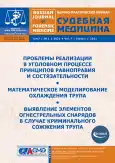Retrospective analysis of forensic sectional examinations after a coronary bypass surgery
- 作者: Rubtsov A.E.1, Rubtsova A.V.1, Morozov M.Y.2, Morozov Y.E.1,2
-
隶属关系:
- Bureau of forensic medical examination of the Department of health of the city of Moscow
- The State Education Institution of Higher Professional Training The First Sechenov Moscow State Medical University under Ministry of Health of the Russian Federation
- 期: 卷 7, 编号 1 (2021)
- 页面: 21-28
- 栏目: 原创研究
- URL: https://journals.rcsi.science/2411-8729/article/view/122402
- DOI: https://doi.org/10.17816/fm332
- ID: 122402
如何引用文章
全文:
详细
Background: In the case of sudden or violent death, occurring in the rehabilitation period after a previously performed coronary bypass surgery, a forensic medical examination is usually prescribed. In recent years, the number of such forensic examinations has increased. At the same time, problems were revealed related to the lack of guidelines for the study of coronary shunts and recommendations on the structure of forensic diagnosis. Aims: This study aimed to summarize significant differences and features of coronary shunt research methods and give examples of diagnosis in cases of forensic examinations of corpses of patients who underwent coronary bypass surgery. Conclusions (acts) of forensic medical examinations (studies) of corpses performed at the bureau of forensic medical examination of the city of Moscow for the five-year period in 2012–2016 were studied. Cases of forensic examinations in patients who had previously undergone coronary bypass surgery were identified, original technical methods for sectional study of postoperative shunts are summarized, and options for constructing and substantiating sectional diagnoses were developed. In the analysis of 135, 446 conclusions (acts), 56 cases of forensic examinations of corpses of persons with signs of previously performed coronary bypass surgery were selected. Distinctive features of original methods for the study of shunts, tasks resolved during the study of native and prosthetic heart vessels, and examples of the design of forensic protocols are described. Examples of construction and substantiation of forensic diagnoses are also provided. Conclusion: This study revealed original technical methods for the study of coronary shunts during the concealment of corpses and examples of protocols of identified changes, and options for the formulation of forensic medical diagnoses in cases of forensic examinations of corpses of persons with a previously performed coronary bypass surgery are given.
作者简介
Alexandr Rubtsov
Bureau of forensic medical examination of the Department of health of the city of Moscow
Email: zulugra@mail.ru
ORCID iD: 0000-0002-5268-6337
SPIN 代码: 4433-4167
Medical Forensic Expert
俄罗斯联邦, MoscowAnna Rubtsova
Bureau of forensic medical examination of the Department of health of the city of Moscow
Email: oblako_01@mail.ru
SPIN 代码: 4430-0723
Medical Forensic Expert
俄罗斯联邦, MoscowMichael Morozov
The State Education Institution of Higher Professional Training The First Sechenov Moscow State Medical University under Ministry of Health of the Russian Federation
Email: 3221vbif@gmail.com
Student of the resource center
俄罗斯联邦, MoscowYuri Morozov
Bureau of forensic medical examination of the Department of health of the city of Moscow; The State Education Institution of Higher Professional Training The First Sechenov Moscow State Medical University under Ministry of Health of the Russian Federation
编辑信件的主要联系方式.
Email: mrzv66@mail.ru
ORCID iD: 0000-0002-0594-257X
SPIN 代码: 4434-5278
Dr. Sci. (Med.), Associate Prof.
俄罗斯联邦, Moscow参考
- Akchurin RS, Shiryaev AA, Vasiliev VP, et al. Modern trends in coronary surgery. Circulatory Pathology and Surgery. 2017;21(35): 34–44. (In Russ). doi: 10.21688/1681-3472-2017-35-34-44
- Khubulava GG, Nemkov AS, Komok VV, Chzan Y. Selection of the transplant for myocardial revascularization. Grekov’s Bulletin of Surgery. 2018;177(5):96–99. (In Russ). doi: 10.24884/0042-4625-2018-177-5-96-99
- Neverova YV, Tarasov RS, Ivanov SV, et al. Results of coronary bypass surgery performed in the early stages of non-ST segment elevation acute coronary syndrome. Russian Journal of Cardiology. 2019;24(8):22–28. (In Russ). doi: 10.15829/1560-4071-2019-8-22-28
- Semchenko AN, Koshkin II. 50 Years of the first operation of mammary-coronary bypass surgery using microsurgical equipment and an operational microscope in the clinic. Circulatory Pathology and Surgery. 2018;22(3):86–94. (In Russ). doi: 10.21688/1681-3472-2018-3-86-94
- Frolov AV. Total arterial myocardial revascularization. Complex Issues of Cardiovascular Diseases. 2018;7(4S):108–117. (In Russ). doi: 10.17802/2306-1278-2018-7-4S-108-117
- Shabaev IF, Tarasov RS, Kozyrin KA. Hospital results of miniinvasive coronary bypass of the anterior descending artery on the working heart. Complex Problems of Cardiovascular Disease. 2019; 8(2):58–67. (In Russ). doi: 10.17802/2306-1278-2019-8-2-58-67
- Alsov SA, Tsirikhov VR, Sirota DA, et al. Microsurgical coronary bypass surgery. features of operating microscope operation. Circulatory Pathology and Cardiac Surgery. 2020;(24):124–128. (In Russ). doi: 10.21688/1681-3472-2020-2-124-128
- Grebennik VK, Kucherenko VS, Fany H, Gordeev ML. Redo coronary artery bypass graft. Risks and results. Bulletin of the N.I. Pirogov National Medical and Surgical Center. 2018;13(3): 20–24. (In Russ). doi: 10.25881/BPNMSC.2018.85.15.004
- Zhbanov IV, Martirosyan AK, Uryuzhnikov VV, et al. Multiple coronary bypass using two internal thoracic arteries. Clinical and Experimental Surgery. Academic B.V. Petrovsky Journal. 2018;6(4):66–74. (In Russ). doi: 10.24411/2308-1198-2018-14010
- Kuznetsov DV, Gevorgyan AA, Novokshenov VV, et al. Bilateral internal thoracic artery coronary bypass grafting. Grekov’s Bulletin of Surgery. 2019;178(3):10–15. (In Russ). doi: 10.24884/0042-4625-2019-178-3-10-15
- Goldman S, Zadina K, Moritz T, et al. Long-team patency of saphenous vein and left internal mammary artery graft after coronary artery bypass surgery: result from Department of Veterans Affairs Cooperative Study. J Am Coll Cardiol. 2004; 44(11):2149–2156. doi: 10.106/i.iacc.2004.08.064
- Green GE. Use of the internal mammary artery in myocardial revascularhation. Ann Thorac Surg. 1988;45(4):453–454. doi: 10.1016/S0003-4975(98)90027-3
补充文件







